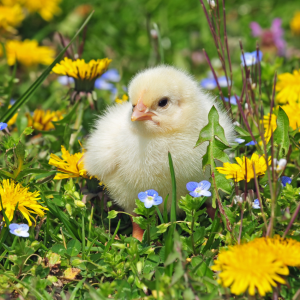Raising Baby Chicks on a Budget – Essential Tips You Can’t Miss!
You may be dreaming of a charming chicken coop in your backyard, but worried about the costs involved. Fear not, dear reader! In this post, I will share with you vital tips on how to raise baby chicks on a budget without compromising their care. From setting up a frugal brooder to sourcing affordable feed and supplies, I’ll guide you through the process with practical advice inspired by the pioneer spirit. Let’s begin on this thrifty and rewarding journey of raising baby chicks together!

Key Takeaways:
- Proper Planning: Plan ahead and budget for necessary supplies like heat lamps, chick feed, and bedding.
- DIY Solutions: Use creative DIY solutions like homemade brooders and feeders to cut costs.
- Bulk Purchases: Buy supplies in bulk to save money in the long run, especially chick feed and bedding.
- Healthy Environment: Ensure a clean and healthy environment for the chicks to prevent costly health issues later on.
- Community Resources: Utilize community resources such as local farmers or co-ops for discounts on chick supplies.
Preparing for Your Flock
Assessing Your Resources
The first step in preparing for your flock of chicks is to assess your resources. Before bringing them home, make sure you have a suitable space set up for them. Consider the size of your coop or brooder, as well as the availability of food and water sources. Ensuring that you have everything in place beforehand will help you provide a comfortable and safe environment for your chicks.
Choosing the Right Breed
In the context of choosing the right breed for your budget-friendly flock, consider characteristics such as egg-laying abilities, temperament, and cold-hardiness. Some breeds are known for being prolific egg layers, while others are more docile and friendly. Additionally, if you live in a colder climate, you may want to choose a breed that can withstand low temperatures. Researching different breeds and their specific traits can help you select the best fit for your needs.
If you’re looking to raise chickens for meat, selecting a dual-purpose breed might be a cost-effective choice, as these breeds are known for both their egg-laying abilities and the quality of their meat. Some popular dual-purpose breeds include Rhode Island Reds and Plymouth Rocks.

Budget-Friendly Brooding
It’s crucial to set up a warm and safe brooding area for your chicks without breaking the bank.
DIY Brooder Ideas
Brooder spaces can easily be created using items you may already have at home. Old cardboard boxes, plastic storage bins, or even a kiddie pool can be repurposed into a cozy brooding area for your chicks. Make sure the brooder has a secure lid to prevent escapes and drafts.
Heating and Lighting Options
Budget-friendly heating options for your chicks include heat lamps or heating pads designed specifically for poultry. Most chicks will need a temperature of around 95°F for the first week, decreasing the temperature by 5°F each week until they are fully feathered. For lighting, a simple clamp light with a low-wattage bulb can provide the necessary light for your chicks’ growth and development.
Plus, it’s crucial to monitor the temperature regularly with a thermometer placed at chick height to ensure they are neither too hot nor too cold. Providing a consistent light-dark cycle of around 18 hours of light will help mimic natural daylight and encourage healthy growth.

Feeding Your Chicks Without Breaking the Bank
Starter Feed vs. Layer Feed
Not all chicken feeds are created equal, and choosing the right one can make a big difference in your budget. Starter feeds are specially formulated for young chicks to support their growth and development. While layer feeds are designed for adult hens that are laying eggs.
Supplementing with Kitchen Scraps
The key to saving on chicken feed costs is to supplement with kitchen scraps. You can feed your chicks a variety of fruit and vegetable scraps from your kitchen, such as lettuce, carrots, and apples. Just make sure to avoid giving them anything that’s harmful to chickens, like avocado or chocolate.
Your chickens will enjoy the variety in their diet, and you’ll be reducing food waste in the process. It’s a win-win situation for both you and your feathered friends!
Growing Your Own Chicken Feed
Your ultimate money-saving solution is to grow your own chicken feed. You can plant a small garden with crops like corn, sunflowers, and pumpkins, which are not only nutritious for chickens but also easy to grow.
Feed costs can add up over time, so being able to supplement or even replace store-bought feed with homegrown options can significantly lower your expenses. Plus, you’ll have the satisfaction of knowing exactly what your chickens are eating and where it’s coming from.

Providing Affordable Housing
To ensure your chicks have a safe and comfortable home without breaking the bank, you can get creative with providing affordable housing solutions. From repurposing materials to building a coop on a shoestring budget, there are various ways to create a suitable living space for your feathered friends without spending a fortune.
Repurposing Materials for Coops
With a bit of imagination, you can repurpose old items to create a cozy coop for your chicks. Look around your house or local thrift store for materials like wooden pallets, old crates, or even unused furniture that can be transformed into a functional and affordable chicken coop. Not only does this approach save you money, but it also gives a unique touch to your chicks’ home.
Building a Coop on a Shoestring
Coop building doesn’t have to be expensive. You can construct a simple yet sturdy coop using basic materials like reclaimed wood, screws, and chicken wire. For instance, you can repurpose an old shed or build a small A-frame coop using readily available materials. Be resourceful and prioritize functionality over fancy features to keep costs low while still providing a safe and comfortable living space for your chicks.

Health and Hygiene on a Budget
Many aspects of taking care of chicks involve maintaining their health and hygiene. This is crucial to ensure they grow into healthy chickens. Here are some crucial tips to help you achieve this without breaking the bank.
Vaccinations and Medications
One of the most important aspects of chick health is ensuring they receive the necessary vaccinations and medications. **Vaccinations** can protect your chicks from common diseases like Marek’s disease and Newcastle disease. **Medications** may be required if your chicks show signs of illness, such as diarrhea or respiratory issues. While it’s crucial to provide these, you can often save money by buying in bulk or opting for generic brands.
Natural Remedies for Common Ailments
When raising chicks, prioritize their health, as it’s the foundation of their well-being. Sometimes, natural remedies can be just as effective as medications. Use herbal teas to alleviate digestive issues, and add apple cider vinegar to their water to boost their immune systems. Garlic also serves as a natural remedy with powerful antibacterial properties.. It’s crucial to research these remedies thoroughly and consult with a veterinarian before use.
To keep your chicks healthy and thriving, proper hygiene is key.
Keeping Your Coop Clean
To maintain a **clean coop** on a budget, regularly **remove** soiled bedding and **replace** it with fresh material. **Disinfect** the coop with a **vinegar solution** to kill bacteria and parasites without the use of harsh chemicals. **Regularly** cleaning **feeding** and **water** containers can prevent the spread of diseases. By implementing these practices, you can create a **healthy environment** for your chicks to grow and thrive.
The well-being of your chickens depends on the care you provide, and a clean coop is crucial for their health.

Managing Your Time and Energy
After bringing home your new chicks, managing your time and energy effectively is crucial to ensure their well-being.
Creating a Daily Routine
Establishing a daily routine helps you stay organized and ensures you meet all the demands of caring for chicks. Start by setting specific times for feeding, cleaning their living area, and checking on their health. By following a consistent schedule, you can avoid missing any important tasks and provide the necessary care your chicks require to thrive.
Delegating Tasks to Family Members
On busy days, don’t be afraid to involve your family members in caring for the chicks. Assigning responsibilities such as feeding, refilling water, or cleaning the coop can lighten your load and create a sense of teamwork within the household. Plus, involving your family in the care of the chicks can be a fun and educational experience for everyone. Delegating tasks to family members allows you to share the workload and ensures that all chores are completed efficiently.
Taking Care of Yourself
Daily self-care is important when raising chicks on a budget. Make sure to schedule breaks for yourself, stay hydrated, and get an adequate amount of rest. Do not forget, taking care of your own well-being is just as important as caring for your chicks. Additionally, don’t hesitate to ask for help from friends or neighbors if you feel overwhelmed. Prioritizing self-care will not only benefit you but also positively impact your ability to care for your chicks.
Delegating some of the responsibilities to others can provide you with time to recharge and prevent burnout. It’s important to recognize when you need a break and take the necessary steps to ensure you can continue to care for your chicks effectively.

Conclusion on Raising Baby Chicks
Taking this into account, raising chicks on a budget can be a rewarding experience. By following necessary tips such as providing a warm and safe environment, offering a balanced diet, and keeping a close eye on their health, you can successfully raise healthy chickens without breaking the bank. Bear in mind, with a little bit of planning and creativity, you can give your chicks the best start in life.
If you’re looking for a more comprehensive guide on raising baby chicks, I recommend checking out Raising Baby Chicks for Beginners: A Step-by-Step Guide. This resource will provide you with detailed instructions and tips to ensure that your chicks grow into happy and thriving chickens.
FAQ’s about Raising Baby Chicks
Q: What are the basic needs for raising chicks on a budget?
A: To raise baby chicks on a budget, you will need a brooder, heat lamp, chick starter feed, waterer, and bedding.
Q: How do I create a cost-effective brooder for my chicks?
A: You can create a DIY brooder using a large cardboard box, heat lamp, and some newspaper or pine shavings for bedding.

Q: What should I feed my chicks to ensure they grow healthy and strong?
A:Feed chicks a high-quality chick starter feed specifically formulated for their nutritional needs, containing essential vitamins and minerals.
Q: How can I save money on heating costs for my chicks?
A: You can save money on heating costs by using a heat lamp with a low-wattage bulb, insulating the brooder, and only heating the area where the chicks are located.
Q: Are there any ways to reduce costs on chick care without compromising their health?
A: Yes, you can reduce costs by buying feed in bulk. Also you can use reusable waterers and feeders, and source free or low-cost materials for bedding and enrichment items.







